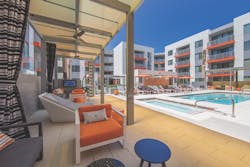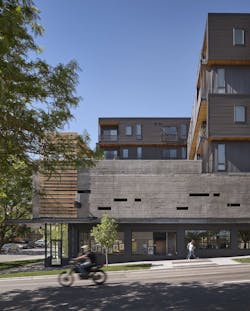Bubble? What bubble?: Apartment and condo construction simply can't keep up with demand
Pay no attention to talk of a multifamily housing bubble. The ranks of potential renters and condo buyers are going up by a million a year, while only 400,000 new units are coming on line.
True, the Federal Reserve Bank recently cautioned lenders about a potential bubble in the luxury arena. In some cities—Miami and New York stand out—the high end of the market may be slowing a bit. But this might be just a temporary pause, as occupancy rates in luxury multifamily dwellings are at or near historic highs.
“Urban cores are still getting a lot of new product,” says Mark Humphreys, AIA, NCARB, CEO of Humphreys & Partners Architects. “There may be a little hesitation now as developers and lenders wait and see how all this is going to get absorbed.”
Since the current multifamily boom took off in 2010, most activity has focused on large urban areas. Recently, the urban cores of smaller cities—places like Des Moines, Indianapolis, and Kansas City—have joined the multifamily parade. Humphreys points out that Kansas City just got its first new downtown apartment tower in 30 years. One Light, a glassy 25-story structure, sold out its priciest units first. Kansas City has 3,600 apartment units under construction or in the planning stages.
With urban cores and locations in close proximity to mass transit finding favor nationwide, the multifamily market is contributing to the “Manhattanization of the U.S.,” says Humphreys. In his hometown of Dallas, the once dead-after-dark downtown has been revivified with new multifamily and mixed-use projects. Now, Big D has a vibrant urban center well into the night.
Growing ranks of baby-boom empty nesters are trading in their suburban single-family homes for smaller, more luxurious city dwellings close to restaurants, retail outlets, and entertainment venues. Humphreys, himself an empty nester, made that move recently. “I didn’t need a 4,000-sf home in the suburbs anymore, so I moved to the urban core,” he says.
The booming Denver market is in short supply of housing for its growing workforce. This 64-unit boutique apartment complex, called MOTO, is designed to address the growing desire for compact housing with shared amenities. Ground-level retail helps to integrate the development into the neighborhood. A spacious pool deck and lobby amenities encourage the mingling of tenants and guests. Gensler was the design architect. Ryan Gobuty, courtesy Gensler.
The huge Millennial Generation—those born between 1981 and 1997—are establishing their own households. This generation, along with their Generation X predecessors, tend to wait longer to have children than their parents did. The result is young adults with enough disposable income to afford higher-end apartments.
“Our developers are still bullish, but they are finding it hard to find projects that pencil,” says Craig Chinn, AIA, Principal, Architecture Design Collaborative. That’s partly due to increases in the cost of labor and construction materials. “A $100 million project a few years ago now costs $115 million,” he says.
Some developers are pressing ahead with land purchases in hot areas but may wait for an economic slowdown to drive down construction costs before breaking ground, says Chinn.
Mixed-use projects continue to find favor in urban and suburban settings—often co-located with large retail developments. Developers of high-end projects are upping the ante on amenities. High-rises feature roof decks with grilling stations, fire pits, pools, spas, and mini-gardens that promote social interaction among residents.
“Amenity spaces are taking inspiration from retail, with premium finishes and materials,” says Christopher Weimholt, NCARB, Principal, Architecture Design Collaborative. Adds Chinn, “They look more like a nightclub with mood lighting and fancy tiles than the institutional look of the past.”
Business centers, which used to be little more than a couple of desks, PCs, a fax machine, a printer, and a small conference room, now have high-end finishes and plush seating so that the rooms look more like a Starbucks than a generic office. This trend lines up with the popularity of co-working office spaces catering to the self-employed.
Also See: BD+C Giants 300 multifamily rankings
Top 95 multifamily architecture firms
Top 40 multifamily engineering firms
Top 90 multifamily construction firms
As for the living units themselves, the sizable contingent of Baby Boomers moving to the urban core is prompting developers and architects to rethink some basic assumptions. “They’re having trouble getting their heads around designing for people accustomed to two- or three-car garages and large walk-in closets,” Humphreys says. The big garage is gone, but even one-bedroom units are getting 8x10-foot walk-in closets and additional storage space in the building. Luxury furnishings may include separated tubs and showers. A to-die-for kitchen is a must, says Humphreys.
Due to the popularity of online shopping, apartment and condominium properties are seeing 50% annual increases in package deliveries. “Some received 300 packages a day during the last Christmas season,” says Humphreys. Tenants and condo owners are even having large pieces of furniture and mattresses delivered. New properties are setting aside a room for package services that notify residents when they have a package; the resident then uses a code to retrieve the package from a locker via electronic access. (See BDCnetwork.com/PackageCenters.)
With an eye on the future, Humphreys says he encourages clients to plan space for solar panels and infrastructure for electric vehicle charging stations. “In San Jose, people are fighting over charging stations for their Teslas,” he says. He’s considering how to provide rooftop space for drone deliveries, and even the possibility of human transportation via drones. Such a service has already been announced in Dubai, he says.
In the multifamily space, demographics are destiny. Given the growth in two key population groups, the future looks promising.

